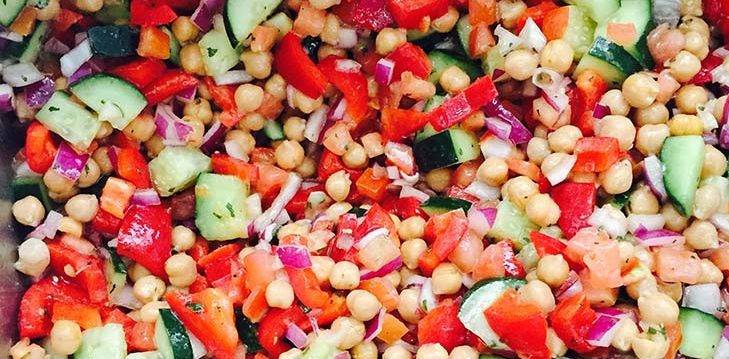Salads are a refreshing meal option during the hottest days of summer. However, not all salads are healthy or satisfying. The most common mistakes we hear as dieticians from Veterans are too many high-calorie or high-fat additions and not enough healthy carbohydrates or lean proteins to make the salad filling enough for a meal.
Here are some tips for turning a salad into a balanced and substantial meal.
- Add some protein: Without a protein source, your salad is not likely to fill you up. Some no-cook options include drained and rinsed canned beans or canned fish, such as sardines, salmon, or tuna. Other options include boiled eggs, fully-cooked rotisserie or grilled chicken, or leftover burgers from the grill. If choosing deli meats, try leaner options including reduced sodium turkey, ham, or trimmed roast beef.
- Vary your veggies: Many salads from fast food restaurants contain lower-fiber vegetables such as iceberg or romaine lettuce, onions, and tomatoes. Fiber is filling. Try adding higher-fiber vegetables, such as bell peppers, broccoli, spinach, sugar snap peas, or cabbage.
- Don’t forget a healthy carbohydrate: My favorite carbohydrates to add to salads are beans (yes-they have protein AND carbohydrates), fresh fruits (think apples, pears, berries), quinoa, brown rice, corn, or leftover sweet potatoes. These will add texture and flavor to your salad. They are also healthier and a more filling option than croutons or crackers.
- Choose a healthy fat, but not too much: Oil and vinegar based dressings are more heart healthy than creamy dressings, like ranch and Caesar. Check the refrigerator aisle or the produce section of your grocery store for yogurt based (lower-fat) versions of these creamy favorites. Other heart healthy options include a small handful of nuts or seeds, or a few slices of avocado. A small sprinkle of cheese works too!
One Veteran in the MOVE program at our VA lost over 60 pounds while still dining at fast-food restaurants most weekdays. He replaces the fried chicken with grilled, skips the salad dressing, and brings his own toppings, such as garlic powder, canned beans or canned vegetables and a fruit cup to complete the meal.
Looking for recipes? Check out this cookbook (download the PDF), which has salad and dressing recipes. If you are taking Coumadin/Warfarin, consult with your PACT registered dietitian before changing your green vegetable intake. To learn more about this or any nutrition-related topic, contact your local VA and ask to speak with a registered dietitian.

Topics in this story
More Stories
Study underscores important role COVID vaccination can have in protecting Veterans from infection and reducing long-term health consequences
Columbia VA’s robotic surgery teams completed their 800th robotic surgery and are on schedule to hit 1,000 by the end of the year.
In a decentralized clinical trial, Veterans can participate from their own homes or local VA instead of having to travel to a research site.







I like this idea, and it can be cheaper than you think….beans, frozen vegetables, peanut butter, and buying vegetables weekly so they don’t go bad if you don’t eat them right away can go a long way!!! Thanks VA move and healthy kitchen programs….tried both. Must admit, I liked the kitchen better…actually mixing, cooking and eating the food were great hands-on experiences.
Great ideas but I can’t afford to eat like this.